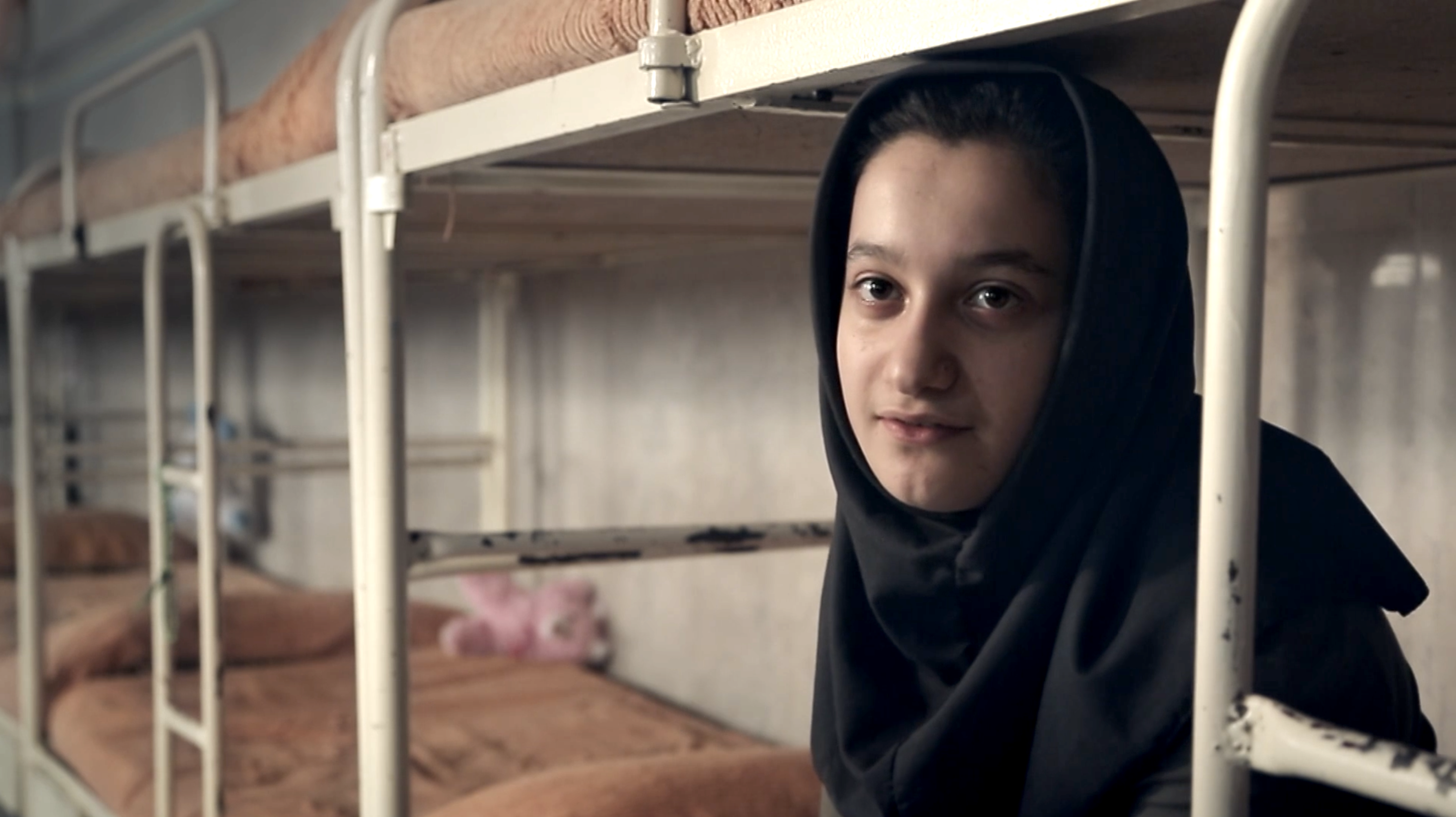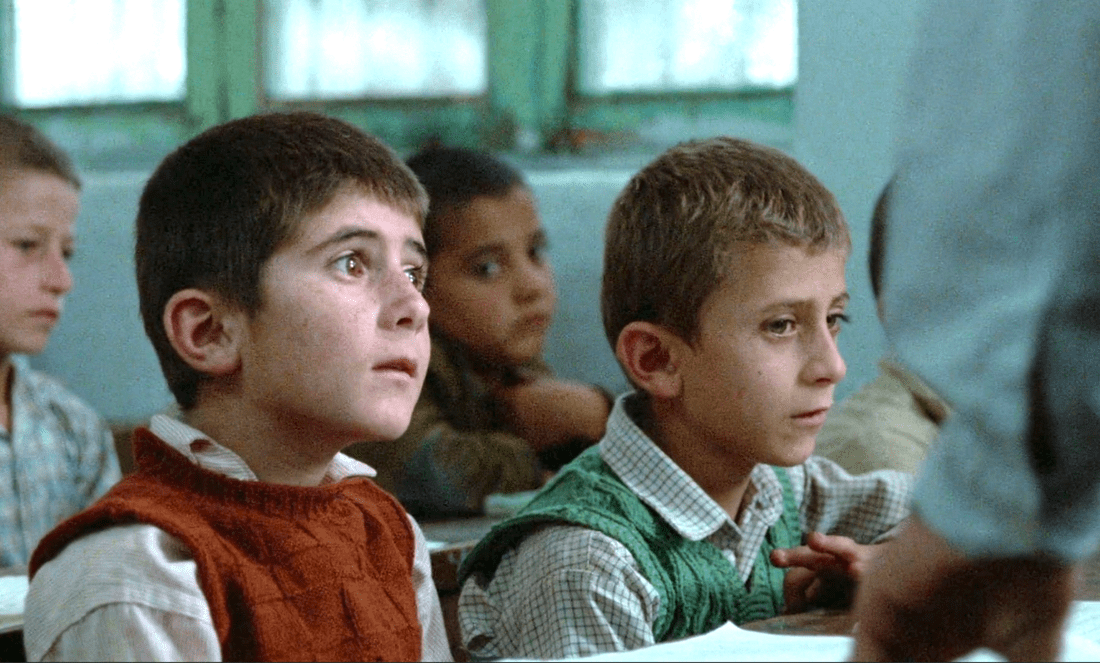
At first, Two-Legged Horse feels like a set-up for a reasonably conventional film about two young boys coming of age in Afghanistan. It has the look and feel of one of Abbas Kiarostami’s Koker films, where colorful characters are played by the inhabitants of a remote village somewhere out in the desert. Like Kiarostami, Samira Makhmalbaf, the director of Two-Legged Horse, has an amazing ability to solicit sincere and compelling performances from untrained actors. It takes only a few scenes for the characters and simple premise to completely take hold of you.
The film centers around two young boys. We never learn their names. There is the rich child, who is missing most of the lower half of his body. He insists on being called The Master. The second boy has some kind of physical, and possibly mental disability. The Master decides to call him Horse.
Despite Horse’s disabilities, he gets hired to take care of The Master while The Master’s father is away on business. Horse’s job mostly consists of carrying The Master to school every day on his back.
Referring to The Master as rich is a relative term. The Master would be seen as very poor in a first-world country, but compared to Horse, who lives in what appears to be an old kiln in the ground, The Master is pretty well off. He has a house, with an adjoining stable, and a woman who comes to clean on occasion. Everything may be dilapidated and covered in dust, but compared to a hole in the ground, The Master is indeed rich.

With the two boys and their relationship as the starting point, the rest of the film seems as if it will be predictable. The boys will begin by not getting along, then they will learn to appreciate each other, then there will be a crisis that will break them up, and then they will be reunited in the end having discovered each other’s humanity. But this is not at all what happens. What appears to be a Kiarostami beginning has more of a Werner Herzog ending.

The relationship these two boys form is horrific and abusive. It begins with The Master whipping Horse with a stick and riding him around. At first, it just seems like childish cruelty, but it escalates. Over time, The Master wares away Horse’s identity and breaks him in, as one might do with a real horse. The Master makes Horse eat hay, and then later, wear a saddle. Eventually, The Master bridles Horse and uses a taught rope as a bit. It’s a slow transformation, and the gravity of the abuse isn’t fully apparent until you see Horse straining against his bit while being brutally ridden by The Master. To make things worse, The Master allows his friends to buy rides on Horse, so they can have a turn laughing at him and beating him.
Like many other Iranian films about children, like Majid Majidi’s 1999 film The Color of Paradise, Abbas Kiarostami’s 1987 film Where is the Friend's House?, or Jafar Panahi’s 1995 film The White Balloon, Makhmalbaf’s Two-Legged Horse appears to be very simple, but all of these films are parables. It is dangerous making films in Iran. Particularly dangerous if you want to address issues of power. This is why so many Iranian films involve children. On the surface, the films appear to be nostalgic stories about the relatively trivial trials and tribulations of children, but it does not take much digging or interpretation to unveil the real messages.

The true message and intention of such films are so obvious, it begs the question if the censors aren’t aligned with the movie makers and are simply looking for plausible excuses to green-light the film’s production and distribution. Two-Legged Horse is just barely a story, it hardly has an arc. Like a Herzog film, it takes a premise and just lets it get worse and worse until the movie ends.
As a parable, Two-Legged Horse is about how power transforms both oppressor and oppressed. Near the end of the film, Horse is presented with a horse mask to wear. It is a final step that will literally mask his human identity and transform him into a beast of burden.

It brings to mind Dariush Mehrjui’s 1969 film The Cow, where the main character transforms himself into the beloved cow he has lost. His cow was his identity, it was what secured his status in the community, and when she died, he was lost without her. Like the main character in The Cow, Horse also feels that his job gives him purpose. He is proud to be earning a dollar a day and excited to be getting attention. Attention, no matter how negative, is still an affirmation that you exist and is often preferred to being ignored.
The transformation Horse endures also feels like what Trelkovsky goes through in Roman Polanski’s The Tenant. Just as in the tenement building where Trelkovsky lives, Horse is surrounded by people who insist on transforming him into something he is not. Both characters are forced to play a role that has no benefit for themselves, but has a benefit for the people around them.

The Cow, The Tenant, and Two-Legged Horse are more concerned with the oppressed than the oppressor. How and why power corrupts the oppressor is often thought to be a simple, forgone conclusion. Sir John Dalberg-Acton’s famous quote, “Power tends to corrupt and absolute power corrupts absolutely”, is almost dismissive of the oppressor in his or her predictability, but the sentence that follows in Acton’s declaration mimics the implied message of Makhmalbaf’s film. “Great men are almost always bad men.” The first half of the saying might make it past the Iranian censorship board, but the radical cynicism of the second half could not be included, only implied. Either way, there is a bitter and angry message about the world’s masters, being sent by a director who is filming in Afghanistan because she has been exiled from her home in Iran. More on that later.
Harder to address and understand are the oppressed. What does the trauma of oppression do to its victims? What keeps the oppressed from running away or rebelling? How can they heal? None of the films The Cow, The Tennant, or The Two Legged Horse feature any redemption. There is no nobility given to the protagonists' suffering, only a desperate illustration of humanity’s limits.
All three protagonists lose their fight. They lose themselves, they lose their freedom and integrity. None of them understand what is happening to them. Their transformation is forced on them from the outside. They resist, but eventually, they internalize the vision of their oppressors and see themselves through the oppressor's eyes.
Throughout Two-Legged Horse, we see the progression of a real horse giving birth to and raising her colt. She licks him clean and we are invited to admire the intimacy between mother and baby. However, once he is clean, it is time for him to stand up. He is only minutes old and his mother begins to kick and shove him. It is not a gentle encouragement. She bullies and harasses the colt into standing up.

Makhmalbaf once said in an interview that she wanted to show the realities that people prefer not to see. We would rather watch the gentle moments between mare and colt, and turn away from the harsh parenting that has evolved to ensure the colt’s survival. There is a force of nature at work, the survival of the fittest. What happens between The Master and Horse is not driven by evolutionary imperatives, but it is a result of our animal drives for dominance. Social animals like dogs, whales, or apes create and constantly test hierarchies. The Master is not what we admire in humanity, but as an animal, he succeeds in enforcing his will and his station in society.
As an allegory, Two-Legged Horse speaks specifically about political power, exploitation, and oppression, but it also speaks to a broader understanding of cruelty and its inextricable role in our psyche. The Master himself was a victim of cruelty. He is missing the lower half of his body because his mother stepped on a land mine while carrying him, killing her and permanently maiming him. By the time we learn this, it is already very difficult to feel any sympathy for The Master, no matter what his past may have been. We would like to point the finger at The Master and label him inhuman, but Makhmalbaf inserts this bit of backstory to make that impossible.

As if humanity's destructive tendencies were not clear enough, a grenade was thrown onto the set of Two-Legged Horse during filming in Afghanistan. Six people were severely injured and a horse was killed. It is still unknown who was responsible, but it is thought that neither the production nor Makhmalbaf was the target. The film was written by Makhmalbaf’s father, Mohsen Makhmalbaf. He is a prominent filmmaker in his own right, and both he and his daughter live in exile from Iran due to past productions. Mohsen Makhmalbaf believes that it was the Taliban who threw the grenade in an effort to retaliate for the making of his film Kandahar.
When the film Two-Legged Horse was finally released, it caused controversy. People were concerned for the well-being of the child actors who had to participate in the depiction of such cruelty, but the uncredited reviewer for the Hollywood Reporter unwittingly addressed exactly the issue Makhmalbaf wanted to bring up. The last line of the review reads, “Perhaps the most human response to 'Two-Legged Horse' is just to look away.” The statement might be a knowing reference to what Makhmalbaf said about her approach quoted earlier in this essay, or the statement might be an unwitting affirmation of Makhmalbaf’s purpose, which only validates Makhmalbaf’s point. The choice to turn away or bear witness is ours.

If you enjoyed this article click here for more
www.filmofileshideout.com/archives/mohammad-rasoulofs-the-white-meadows



